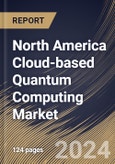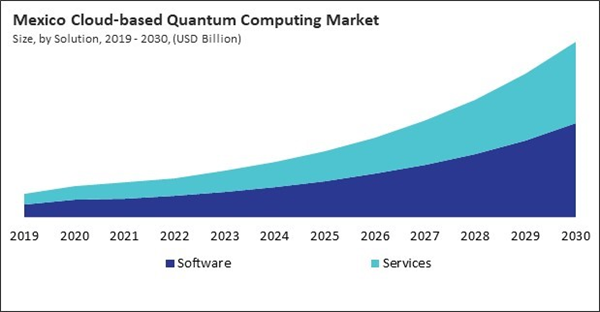The US market dominated the North America Cloud-based Quantum Computing Market by Country in 2022, and would continue to be a dominant market till 2030; thereby, achieving a market value of $610.2 million by 2030. The Canada market is experiencing a CAGR of 21.9% during (2023 - 2030). Additionally, The Mexico market would exhibit a CAGR of 20.8% during (2023 - 2030).
The technological landscape is undergoing a revolutionary transformation propelled by the promise of quantum computing. The emergence of cloud-based computing plays a leading role in this paradigm transition. Quantum computing is positioned to bring about a paradigm shift in various sectors and address intricate challenges that traditional computers cannot surmount, owing to its exceptional computational capabilities governed by the principles of quantum mechanics. Integrating quantum computing into cloud services heralds a new era, democratizing access to quantum resources and accelerating innovation across diverse sectors.
Additionally, the evolution of quantum computing as a service model, commonly known as Quantum as a Service (QaaS), has been a pivotal enabler for cloud-based computing. QaaS allows users to access quantum resources, experiment with quantum algorithms, and integrate quantum capabilities into their workflows through cloud platforms. Leading cloud service providers, including IBM, Microsoft, Google, and Amazon, have embarked on the QaaS journey, making quantum resources available on a pay-as-you-go basis.
Mexico has become a key player in the automotive industry, attracting major manufacturers and contributing significantly to the production of vehicles and automotive components. Quantum computing can accelerate materials science research in the automotive sector. As per the data from the International Trade Administration, Mexico ranks the seventh-largest producer, with an annual production of 3.5 million passenger vehicles. Out of the total number of vehicles manufactured in Mexico, 88 percent are exported, with 76 percent being allocated to the United States. Hence, North America's rising automotive and BFSI sectors will boost the demand for this market in the region.
Based on Solution, the market is segmented into Software, and Services. Based on Technology, the market is segmented into Superconducting Qubits, Trapped Ions, Quantum Annealing, and Others. Based on Application, the market is segmented into Optimization, Simulation & Modelling, Sampling, and Others. Based on Vertical, the market is segmented into BFSI, Healthcare, Automotive, Energy & Power, Aerospace & Defense, Government, Chemical, and Others. Based on countries, the market is segmented into U.S., Mexico, Canada, and Rest of North America.
List of Key Companies Profiled
- Google LLC (Alphabet Inc.)
- Microsoft Corporation
- IBM Corporation
- Amazon Web Services, Inc. (Amazon.com, Inc.)
- Baidu, Inc.
- Huawei Technologies Co., Ltd. (Huawei Investment & Holding Co., Ltd.)
- Terra Quantum AG
- SpinQ Technology Co., Ltd.
- QpiCloud Techonologies
- CERN
Market Report Segmentation
By Solution- Software
- Services
- Superconducting Qubits
- Trapped Ions
- Quantum Annealing
- Others
- Optimization
- Simulation & Modelling
- Sampling
- Others
- BFSI
- Healthcare
- Automotive
- Energy & Power
- Aerospace & Defense
- Government
- Chemical
- Others
- US
- Canada
- Mexico
- Rest of North America
Table of Contents
Companies Mentioned
- Google LLC (Alphabet Inc.)
- Microsoft Corporation
- IBM Corporation
- Amazon Web Services, Inc. (Amazon.com, Inc.)
- Baidu, Inc.
- Huawei Technologies Co., Ltd. (Huawei Investment & Holding Co., Ltd.)
- Terra Quantum AG
- SpinQ Technology Co., Ltd.
- QpiCloud Techonologies
- CERN
Methodology

LOADING...









